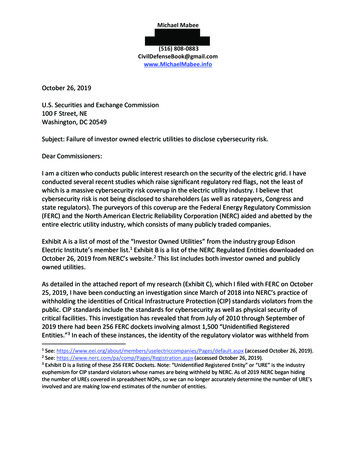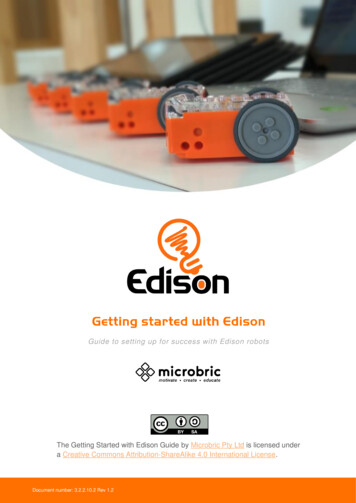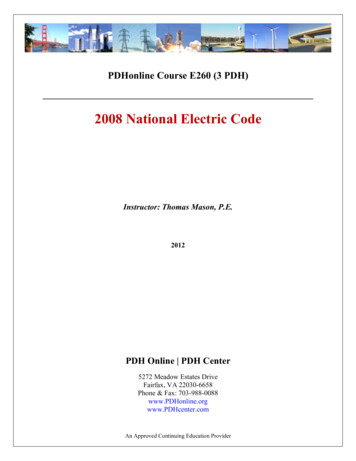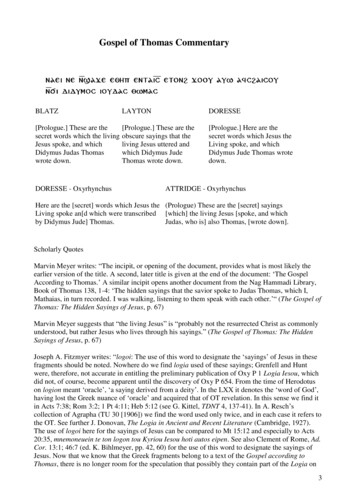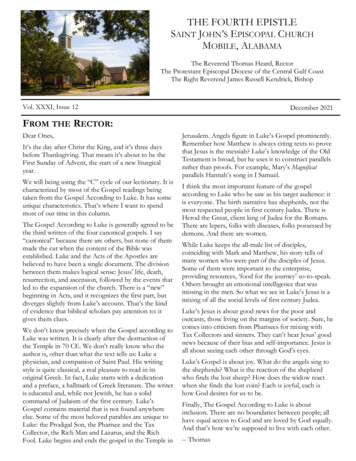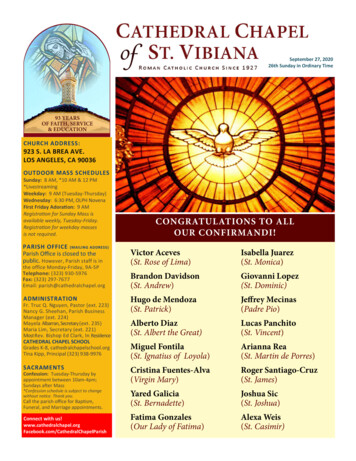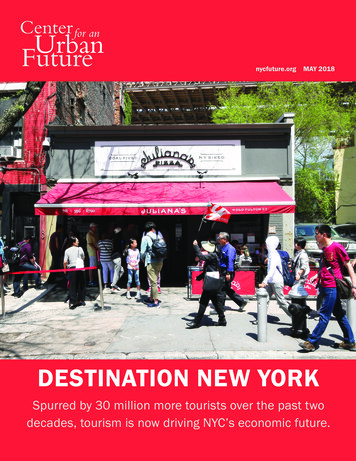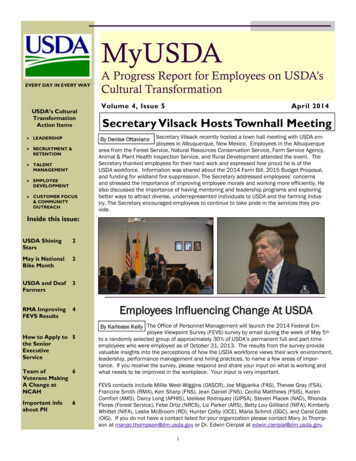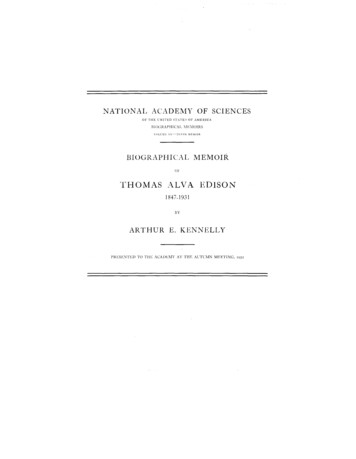
Transcription
NATIONAL ACADEMY OF SCIENCESOF THE UNITED STATES OF AMERICABIOGRAPHICAL MKMOIRSBIOGRAPHICAL MEMOIROETHOMAS ALVA EDISON1847-1931BYARTHUR E. KENNELLYPRESENTED TO THE ACADEMY AT THE AUTUMN MEETING, 1932
THOMAS ALVA EDISONBirth and ParentageThomas Alva Edison, probably the greatest inventor thatAmerica has produced, was born at Milan, Ohio, on Februaryn t h , 1847.According to family records, the paternal ancestor of theEdisons landed in New Jersey, from Holland, about the year1730. The family on Edison's mother's side, the Elliotts, wasof Scotch-English origin and settled in New England prior to1700. The Edisons were a vigorous, hardy stock. The inventor's great-grandfather, Thomas Edison, lived to be 104years old, John Edison, his grandfather (1750-1852), to 102,and Samuel Edison, his father (1804-1896), to 92. They wereall men of endurance and strong physique. Great-grandfatherThomas took an active part against the British Government inthe Revolutionary War of 1775-1781 ; while grandfather JohnEdison, who was a young man of 25 when the war broke out,sided with the loyalists. When the great exodus occurred in1783, and many thousands of loyalists embarked for Canada,John Edison was among them. Father Samuel Edison wasborn at Digby, Nova Scotia, in 1804. John finally settled atVienna, Ontario, close to the northern shore of Lake Erie, andthere he remained, as a Canadian citizen, to the end of his life.In 1828, Samuel Edison, the inventor's father, marriedNancy Elliott (1810-1871), a school teacher at Vienna. Shewas a clever, brilliant and attractive woman, the daughter ofa Baptist clergyman and granddaughter of Captain EbenezerElliott of Scotch ancestry, who fought on the American side inthe Revolutionary war, and who finally settled at Vienna,Ontario, where he lived to an age of over 100 years.In 1837, when political disturbance in Ontario culminatedin rebellion against the British government, Samuel Edison.33 years of age, tall and of strong physique, was fighting asa Captain in Mackenzie's insurgents. For the second time, theyounger member of the Edison family found himself on the287
NATIONAL ACADEMY BIOGRAPHICAL MEMOIRSVOL. XVside of a lost cause. Samuel Edison had to make his escapewith his wife, through dangerous country, to the southern shoreof Lake Erie. They finally settled at Milan, Ohio. Herethree children were born: William Pitt, Tannie, and the subsequently famous Thomas Alva, the last named on Februaryn t h , 1847. All three children showed ability, but that of thetwo eldest was of an artistic and literary character.Boyhood (1854-1868)When young Edison was seven years old, his family removedfrom Milan, Ohio, to Port Huron, Michigan, through whichtown the Grand Trunk Railroad had laid its tracks along theSt. Clair River which separated Michigan from Ontario. Theboy was good-natured and courageous. Most boys are wellendowed with curiosity, but little Thomas seems to have hadcuriosity insatiable. He used to express surprise that thegrown-up people round him were unable to answer his numerous questions. He spent three months at the Port Huronpublic school, that being all the formal schooling he ever had.As a scholar, he does not appear to have made a success. Hismind was keen enough; but did not follow the grooves ofschool learning. His mother, who had been a teacher, andunderstood him, attended to his education herself. Under herguidance he became proficient in reading and writing. Arithmetic he never cared for. He soon revealed a great thirst forexperimenting, and especially for chemical experimenting. Hespent his pocket money on inexpensive chemicals, and his sparetime in the family cellar, trying out their properties—to see ifwhat the book said was true. Throughout his life, Edisonnever accepted a text-book statement as final, until it had beentried out.When the boy was eleven years old, he commenced his firstventure in business, by taking family garden produce to marketin Port Huron, in a little horse wagon, with the aid of anotherlad. At twelve years of age, he applied for and secured a concession from the Grand Trunk Railroad to sell newspapers onthe trains between Port Huron and Detroit (a distance of 100
THOMAS AIA'A EDISONKENNELVVkm. or 62 miles). In this way he was able to gain more pocketmoney for chemicals and experiments. He not only kept upthis newsboy work on the trains; but also extended it, byemploying other boys as assistants on other trains, and openingtwo small stores in Port Huron, each operated by a boy companion. Later he transferred part of his stock of chemicalsfrom the family cellar to the baggage car of the train on whichhe worked. He was very popular with the trainmen, whoknew him as "Al". A photograph of little Al, at about fourteenyears of age, shows a cheery, plucky lad, in a train-boy's cap,full of keen interest in the world. About this time, he purchased in Detroit a small hand printing press, with forms andtype. He persuaded the train conductor to let him mount thisin the baggage car, and so organized not only the first railwaychemical laboratory; but also the first railway printing press,collecting the news, composing, setting, printing and selling thesheets, all himself. The circulation of this single sheet, "TheWeekly Herald", amounted to 800 copies.It was in 1862, when Edison was fifteen years old, carryingregularly an eighteen-hour workday, that an accident occurredwhich left him with a permanent deafness in both ears. Running over a rough piece of track, the baggage car, with itsEdison corner laboratory, jolted to the floor a stick of phosphorus. This started a fire in the car that took all the effortsof Edison and the train crew to subdue. The conductor wasso angered that he soundly boxed young Thomas' ears. Whenthe train stopped, all the stock of the laboratory and printingpress was thrown out on the station platform, to his greatdistress. In Edison's opinion, the injury to his hearing, thatmay have been caused by the cuffing, was intensified later, whena friendly trainman tried to help him climb on a baggage car,by pulling on his ears.The slight deafness which came on after these events becamepermanent and gradually increased in later years. A man oflesser calibre might well have become morose by this infirmity;but it certainly did not have that effect upon Edison. Hisdisposition remained throughout life, sunny, kindly and serene.2?A)
NATIONAL ACADEMY BIOGRAPHICAL MEMOIRSVOL. XVIn fact, he used to claim that his deafness was an asset; sinceit permitted him to concentrate his thoughts upon any desiredobject of study, even among intensely noisy surroundings. Itwas a remarkable vindication against fate, when this partiallydeaf man later discovered, invented and perfected the phonograph.In August, 1862, an incident occurred which changed thedirection of young Edison's career. The train on which hewas newsboy was at Mount Clemens Junction, where freightcars were shifted. A box car was being shunted, at considerable speed, to a side track. The station agent's little son, thetwo-year-old Jimmie Mackenzie, had strayed to play on thisside track, right in the way of the oncoming box car. YoungEdison on the platform saw the danger. Casting aside cap andbundles, he jumped on the track and reached the child just intime to haul him clear. As it was, one front wheel of the carstruck his heel, and threw him with the child to the side ofthe track, on the stone ballasting. Their faces and hands werecut; but no serious injury had been incurred.On the following day, Mackenzie offered to teach the ladMorse telegraphy, with a view to helping him secure, later on,a position as railway telegraphist. Edison accepted, and in afew months, taking lessons three times a week, between traintimes, together with practice at odd hours elsewhere, heattained proficiency at the key.For the next six years, Edison followed the career of atelegraphist. During that time, he wandered, in the service ofthe Western Union Telegraph Company, through a number ofcities in the middle west, and the south as far as New Orleans.He became noted as a rapid and accurate operator, frequentlybeing assigned to press work on night duty. He adopted forthis work a clear, fast and upright style of handwriting, whichafterwards always characterized his penmanship. He spent allhis available leisure in experiment and study. Faraday's "Electrical Researches" particularly interested him, owing to theirclose dependence upon experiment, their imaginative appeal,290
THOMAS ALVA EDISONand their freedom from mathematical symbolism. He alsoacquired, in the course of his journalistic daily work, and withhis retentive memory, a large fund of general information.Entrance to Edison's Career as an Inventor (1868-1876)In October, 1868, when Edison was 21 years old, he appliedfor his first American patent—a vote recorder. This was adevice which enabled the affirmative and negative votes of aseated voting assembly to be swiftly recorded and automaticallytotaled at the chairman's desk. Edison succeeded, after mucheffort, in demonstrating the invention at Washington, beforethe appropriate committee of Congress, only to find that therewas no demand for a mechanism of that kind. Unsuccessfulbut undismayed, Edison returned to his little workshop inBoston. About this time he gave up the career of a telegraphist, and devoted himself entirely to invention. He commenced with an improved telegraphic "stock ticker." In 1869,when he went to New York, the nation was off the goldstandard, as a result of the recent civil war, and the marketratio of gold bullion to government notes was constantly shifting in the "Gold Room" of the Wall Street Exchange. Atransmitting instrument, not of Edison's design, operated froma keyboard in the Gold Room, issued the fluctuating gold quotations over wires to brokers' offices in the vicinity, each officehaving a dial-indicating receiver. On the third morning afterhis arrival in New York, Edison was standing near the transmitter, which, as a specialist, he had carefully examined, whenit became suddenly deranged by an internal accident, thusthrowing out of action all the indicators in the connectedbrokers' offices. In the ensuing tumult, he realized the natureof the derangement and volunteered to correct it. His offerwas accepted, and he was able to restore normal operationvery speedily. This led to his being made manager of thesystem, which he proceeded to improve and develop with newinventions. The new Edison Stock Ticker was a great advancein many respects over the earlier device, and brought him muchrenown.291
NATIONAL ACADEMY BIOGRAPHICAL MEMOIRSVOL. XVEdison used to describe, from personal observation of thegold-quotation system in New York City, the sensational eventsof the financial panic on Black Friday, September 24th, 1869,when gold went to a high premium. Prices rose so rapidly thathis system had difficulty in keeping up with the market. Itwas characteristic of him, that while he was for a number ofmonths an operating personage in a continual stream of speculation, he never speculated himself, nor even felt any impulseto speculate. He was constantly at work, either in the office ormachine shop, testing or improving.A few days after Black Friday, he entered into the firstrecorded American firm of Consulting Electrical Engineers,under the title of Pope, Edison and Company, 80 Broadway,New York.After the successful sale of some of his inventions to theWestern Union Telegraph Company, Edison opened machineshops at Newark, New Jersey, for invention and manufacture.He kept 50 workmen busy, and when orders came in heavily,a night force also. He served as foreman for both gangs,which meant living on the premises and taking short periods ofsleep at odd intervals during the twenty-four hours. Here hedeveloped a number of telegraph inventions, in particular, thequadruplex for sending and receiving four messages simultaneously over a single wire—two in each direction—, and thehigh-speed automatic telegraph. During the Newark period(1870-1876) he took out nearly 120 American patents, almostall in electric telegraphy.In 1871, Edison married Mary G. Stillwell, by whom he hadthree children, Marion E., Thomas A., and William L. Edison.Menlo Park Period (1876-1884)Edison moved his laboratory from Newark in 1876, toMenlo Park, New Jersey, a small village on the PennsylvaniaRailroad between Rahway and Metuchen, New Jersey, wherehe could concentrate on invention; since he found the combination of invention and manufacture too strenuous,. even for hisenergetic temperament. This was the year of the Centennial292
THOMAS ALVA EDISONKENNKLLYExhibition at Philadelphia, at which the new Bell telephonewas first shown to the public. The original Bell telephoneapparatus did not have a satisfactory transmitter, and Edison,after much experimental labor at Menlo Park, produced acarbon-button transmitter that virtually converted the telephone from an experimental to a commercially available apparatus. It was in his experimenting with the carbon transmitter, that Edison coined the now well-known call word"Hello", which spread out from Menlo Park until it becameadopted by telephonists all over the world. He also inventedabout this time, in Menlo Park, a new ingenious non-magnetictype of telephone receiver; since he was prevented from usingthe Bell electromagnetic receiver. It operated on the principleof electrolytically varied friction between two conducting surfaces in rubbing contact. This instrument, called the electromotograph receiver, had certain advantages in special cases,and produced very loud sounds; but did not come into extensive telephone use.In 1877, Edison discovered and developed the first stages ofhis phonograph or talking machine, which was justly regardedas a great wonder at that time. Owing to the pressure of otherinventions, however, he was reluctantly compelled to set thisinstrument aside for a time, and leave its further developmentto later years.In 1878 he took up the inventive problem of "subdivision ofthe electric light". At that time the arc light, originally discovered by Davy in 1809, had been developed and had comeinto commercial use for the illumination of halls and streets;but it was too powerful for interior use, and the problem therefore was to substitute a number of small electric lamps for asingle arc lamp. A number of inventors had already experimented with glow lamps or incandescent lamps; but no successful result had been achieved. Edison realized that a commercial incandescent lighting system would require its lamps to beconnected "in parallel", between the main conductors, like therungs of a ladder, and not "in series", or end-to-end connection,as had been the leading idea. This required that each lamp293
NATIONAL ACADEMY BIOGRAPHICAI, MEMOIRSVOI,. XVshould have a long, thin, high-resistance filament, a conditionthat greatly increased the difficulties of the problem. Aftera vast number of failures, his first partially successful lamp hada filament of carbonized cotton thread, mounted in a highlyevacuated glass globe, with sealed-in platinum-wire leads. Thislamp, in October, 1879, glowed for 45 hours before breaking.After that, success was gradually reached. It came throughovercoming, in succession, a large number of small difficulties,any one of which could have destroyed the project.A new industry had then to be created from the Menlo Parklaboratory results. A lamp factory, a dynamo factory, factories for making operating instruments, testing instruments,main conductors, etc., all had to be set up and standardized.The early lamps were all operated by voltaic batteries, andalthough there were dynamos for operating arc lamps, therewas none in existence for operating incandescent lamps inparallel. Such dynamos had to be designed and built. Thesewere at first driven by leather belts from the standard lowspeed steam engines of that period, the speed of which, althoughsatisfactorily steady when driving factory machinery, fluctuatedappreciably when used for incandescent lighting service.Edison realized that these belts could not be used in permanent reliable central stations; so new types of high-speedengines, with heavier fly-wheels, had to be developed forcoupling directly to the dynamo shafts. After a number ofsmall incandescent-lighting plants had been successfully set inoperation, it was decided to open a central incandescent stationin the center of the down-town business district of New YorkCity, at 257 Pearl Street, with underground conductors. In allof this work, Edison was his own chief engineer.The Pearl Street Station turned on its current to the lampsin the district, September 4th, 1882. It was successful fromthe first, the system gradually expanding over the whole ofNew York City. Although domestic gas lighting was then generally used, the new incandescent lamps won popularity throughtheir steadiness, coolness, freedom from combustion products,and reduced fire hazard. About the same period, Edison incan294
THOMAS ALVA EDISONKEdescent-lighting stations and systems began to be developed allover the world.Edison foresaw that the successful introduction of the incandescent lamp into factories and homes would immediately admitthe use of the electric motor for operating machinery andhousehold power devices. A few motors had already beenemployed on constant-current series-arc circuits; but the constant-speed self-regulating motor, taking power from constantvoltage mains, could not be produced until the incandescentlamp led the way. The first Edison motors were operated atMenlo Park in 1880, and rapidly developed on the Edisonthree-wire systems, and in Sprague electric-railway systems.There were several standard characteristics of the Edisonsystem worked out at Menlo Park, that have remained but littlechanged to this day. One of these was the lamp voltage, whichhe early set at or near n o volts. A second standard was an inter-connected system of underground iron pipes, carrying withinthe insulated copper conductors which supplied the lamps. Edison realized that all these wires must go underground in largecities, and he faced the mechanical and electrical difficulties ofthat procedure, which were initially very great. The thirdcharacteristic was the invention in 1880 of an important divisionof the underground conductors into two classes: i. e., mains,which exclusively supplied the lamps, and feeders, which exclusively supplied the mains. By this means, a large saving wasmade in the total weight and cost of the copper conductingsystem.- The fourth, very soon after the starting of the PearlStreet Station, was the invention of the "three-wire-system",by which, although the conductors in the system were increased throughout from two to three, yet the total amount ofcopper in the system was again reduced to about one-third;because all the conductors could be considerably reduced insize.The demands of the electric light and power industry onEdison's time were so great that during his stay at the MenloPark laboratory, he could give but little attention to the newdiscoveries and inventions which he was constantly making.29s
NATIONAL ACADEMY BIOGRAPHICAL MEMOIRSVOL. XVOne of these discoveries was in 1883—the "'Edison effect" ; i. e.,a discharge phenomenon that occurred in the lamps, when beingexhausted; whereby a gaseous discharge passed from the glowing filament to the positive filament clamp, and also produced adeposit on the inner surface of the glass bulb. In later years,Fleming, De Forest and others developed this into the thermionictube, now so widely used. Another discovery, which he made atNewark in 1875, was a device for generating and detectinghigh-frequency electric waves, such as Hertz investigated in1889. and which later gave rise to modern radio telegraphy.Edison's generator was a vibrating-contact induction coil, oreven an electric trembling bell-, with one terminal connected towater-pipe ground. The receiver was a small wooden darkbox, in which the opposed electrodes, consisting of graphitepencil points, could be brought into adjustable close proximity.When one electrode was connected to ground, and the other toany short open wire, small sparks could be seen to pass betweenthe minutely separated carbon points in the dark box, if thelatter was in the same building as the generator, or in some adjacent building. These results were so different from those ordinarily associated with electrical circuits, that Edison thoughtthey might be some new phenomena, which he called "Ethericforce". It required long researches of later years, in variouscountries, to link Edison's experiments of 1875 with electromagnetic waves and radio communication.Llewellyn Park Period (1887-1931)Edison moved his laboratory from Menlo Park to New YorkCity, after his wife's death at Menlo Park, in August, 1884,and he gave up his home there soon afterwards. In 1886, hemarried Miss Mina Miller of Akron, Ohio. They made theirhome at Glenmont, Llewellyn Park, West Orange, New Jersey,and there they lived for the rest of his life. Their threechildren are Madeleine, Charles and Theodore. Edison builta commodious laboratory in West Orange, New Jersey, closeto Llewellvn Park, and commenced work there in October,1887.296
THOMAS ALVA EDISONKEN NELLYAt Orange, Edison perfected the phonograph, and made along series of inventions, including the alkaline storage battery,the moving-picture camera, synthetic rubber, the telescribe, themagnetic ore separator, various improvements in manufacturingconcrete and other chemical products, as well as many war inventions for the United States Government. The list of theseOrange laboratory inventions is so long that it cannot be attempted here. For instance, he developed his moving picturecamera until he obtained some satisfactory reels of sporting contests. The moving picture industry of today acknowledges itsstart at the Orange laboratory.PersonalityThe outstanding qualities with which Edison impressed thosewho met him, were energy, frankness, courage and kindliness.He was tall, and powerfully built, with a large head and acountenance open and engaging, but leonine in repose.He was a terrific worker, especially before his fiftieth year.He would often work at his laboratory or factory for twentyhours at a stretch, with only brief pauses for meals, concentrating on one study at a time. His assistants worked in thesame way, and he did not spare them, because he never sparedhimself. It was not that he actually dismissed assistants whodid not work hard; it was the easy-going assistant who dismissed himself and disappeared from the picture. When engaged on some difficult problem like the incandescent lamp,he and his staff worked together days, nights, Sundays andholidays, until they became unmindful of time. He was ableto infuse them with his own enthusiasm.When working regularly at a less feverish pace, he securedrecreation from change of work. Above all things, he loved toinvent some new or better thing than the thing he saw. Heordinarily carried about in his pocket a standard small-sizedyellow-page notebook that might last a week. On the successive pages of this he would write down inventive ideas as theyoccurred to him, usually with some small illustrative sketch orsketches, together with the date and subject. He would stop297
NATIONAL ACADEMY BIOGRAPHICAL MEMOIRSVOL. XVin the middle of a meal or conversation, or immediately onawaking, to write out an invention. In the course of a day,he might make twenty such rough designs. They might benearly all in the same field; or they might differ greatly,depending much upon his surroundings during that period.One or two of these he would proceed to try out himself. Theothers he would probably distribute among his assistants to tryout. He was ever incredulous about any invention that workedout successfully on the first trial, and always wanted to knowwhat was the outstanding difficulty to be overcome. He wasunfailing in encouragement and sympathy when difficultiesbeset an assistant's path, and suggested methods of surmountingthem. Many of his first-sketch inventions proved to be impracticable, often for commercial reasons, and he did not expectmore than a small percentage to survive laboratory tests; butfertility of imagination ran through them all. Moreover, henever sought to patent any process of which the inventive ideawas not his own. More than one thousand American patentswere issued to him during his career; but these were only forthe residual inventions that he selected as probably workableand economically capable of self support. The vast majoritynever got beyond the notebook or the laboratory stages.His method of attacking an inventive problem of majorimportance was always the same. He would attempt nothinguntil he had a clear comprehension of the existing state of theart, preferably from watching the latest process, or examiningmodels; but otherwise by reading up the literature of the art.His memory for facts was most retentive, and he had acquireda habit of reading ordinary descriptive text by the line, insteadof by the word, so that he could run through reports andpamphlets at great speed. He would then lay out in his notebook several plans for simultaneous experimental attack. Asa confirmed optimist, he never doubted that an open path couldbe found for reaching the desired goal, provided that everypossible plan was tried, regardless of established opinion ortextbook authority.298
THOMAS ALVA EDISONKENNEELYHis patience and tenacity in following up experimentalimprovements were most remarkable. He seemed to defy discouragement. He would spend weeks at a time on the improvement of the phonograph, teaching it, as he said, to say "specie".The delicate sybillant associated with the c was difficult forthe instrument to render. It would return the word as"spee—ee". He succeeded finally to his satisfaction, but notwithout trying a very large number of devices.In temperament he was simple, modest, direct and kindly. Itwas impossible for him to pose or assume airs. Although hispractical knowledge was extensive in many branches of science,he never claimed to be more than an inventor. With thealertness of his active mind, he tended to take a definite opinionon any proposition that might be presented to him; but hewould listen very tolerantly to opposite views, and give waypleasantly to facts or demonstration. In general, however, hisviews proved to be reliable and based upon experience. Hepossessed a certain charm of manner which endeared him tohis associates. Furthermore, he had the rare gift of securingthe mutual good will of his assistants; so that dissension amongthem was very exceptional. It is generally admitted that hewon esteem and goodwill everywhere. His only detractors havebeen those who did not know him personally.As an evidence of the loyalty of Edison's associates to himpersonally, it may be pointed out that, in 1918, a voluntary association was formed, called the "Edison Pioneers". The membersare "Those persons who were associated with Thomas A.Edison, or connected with his work up to and including theyear 1885." Associate members are those who came later(1886-1931, inclusive). The Edison Pioneers meet annuallyin New York City on Mr. Edison's birthday. At the presentdate (1932), there are 100 members and 136 associates. Thismemoir has been prepared with the help of the organization.At public receptions, he was shy and retiring. He dreadedto be called upon to make a speech. In private life, however,he showed a remarkable talent for humorous narrative, and he299
NATIONAL ACADEMY BIOGRAPHICAL MEMOIRS—VOL. XVenjoyed listening to a good story. His life was a happy one.He was of very temperate habits, except in regard to hours ofwork. To the acquisition of wealth he was indifferent, exceptfor the opportunities it brought for more inventions andaccomplishments.Honors and AwardsAfter his invention of the phonograph in 1877, honors cameto Edison with increasing rapidity. The following honoraryacademic degrees were conferred upon him: Ph.D. Union College, 1878; D.Sc. Princeton, 1915; LL.D. University of theState of New York, 1916.The following is a partial list of his medals and decorations:Legion of Honor, France, Chevalier 1879, Officer 1881, Commander 1889.American Institute of the City of New York, Medals ofSuperiority, for Electric Pen, 1878, for Multiplying Press,1878. Medals of Excellence for Chemical Telephone,1879. For Carbon Telephone, 1879.Cross of Grand Officer (Count) of the Crown of Italy, 1889.Rumford Gold Medal, American Academy of Arts & Sciences.Albert Medal of the British Society of Arts, 1892.Honorable Consulting Engineer, St. Louis Exposition, 1904.John Fritz Gold Medal, 1908.Rathenau Gold Medal (Germany), 1913.Civic Forum Gold Medal, 1915.Medal of the Franklin Institute, Philadelphia, 1915.President of the Naval Consulting Board, 1915.Distinguished Service Medal of the United States Navy Department, 1920.First Recipient of Edison Medal of American Institute of Electrical Engineers, New York City, 1923.Membership in National Academy of Sciences, Washington,D. C , April, 1927.Society of Arts and Sciences Gold Medal, 1928.Congressional Gold Medal, 1928.300
THOMAS AL.VA EDISONPatentsThe following is a list of 1,091 American Patents grantedby the United States Patent Office to Edison during his career.They are listed according to the numbers whose applicationswere executed by him in each successive year between 1868and 1928, inclusive, representing over sixty years of inventiveactivity. The individual titles of these applications up to theyear 1926 are recorded in the Biography of Dyer, Martin andMeadowcroft (Bibliography No. 1). During the same working period he also had received up to 1910, 1,239 foreignpatents, distributed among 34 foreign countries.No. ofpatentsgrantedI4783825IS1
what the book said was true. Throughout his life, Edison never accepted a text-book statement as final, until it had been tried out. When the boy was eleven years old, he commenced his first venture in business, by taking family garden produce to market in Port Hur

